2022 TOYOTA COROLLA battery
[x] Cancel search: batteryPage 207 of 678
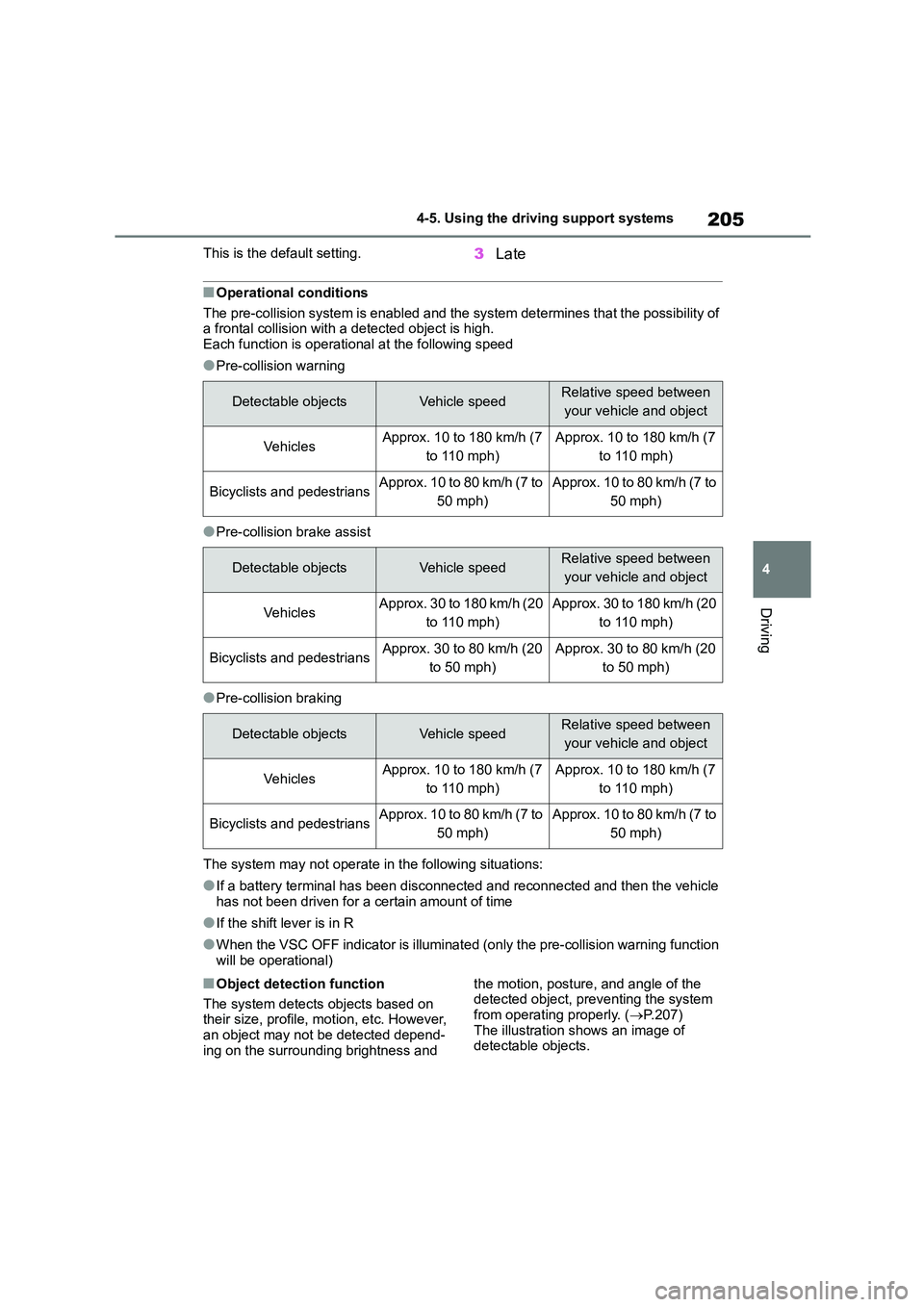
205
4
4-5. Using the driving support systems
Driving
This is the default setting.3 Late
■Operational conditions
The pre-collision system is enabled and the sy stem determines that the possibility of a frontal collision with a detected object is high.
Each function is operational at the following speed
●Pre-collision warning
●Pre-collision brake assist
●Pre-collision braking
The system may not operate in the following situations:
●If a battery terminal has been disconnected and reconnected and then the vehicle
has not been driven for a certain amount of time
●If the shift lever is in R
●When the VSC OFF indicator is illuminated (only the pre-collision warning function
will be operational)
■Object detection function
The system detects objects based on their size, profile, motion, etc. However,
an object may not be detected depend-
ing on the surrounding brightness and
the motion, posture, and angle of the
detected object, preventing the system from operating properly. ( P.207)
The illustration shows an image of
detectable objects.
Detectable objectsVehicle speedRelative speed between
your vehicle and object
VehiclesApprox. 10 to 180 km/h (7
to 110 mph)
Approx. 10 to 180 km/h (7
to 110 mph)
Bicyclists and pedestriansApprox. 10 to 80 km/h (7 to
50 mph)
Approx. 10 to 80 km/h (7 to
50 mph)
Detectable objectsVehicle speedRelative speed between
your vehicle and object
VehiclesApprox. 30 to 180 km/h (20
to 110 mph)
Approx. 30 to 180 km/h (20
to 110 mph)
Bicyclists and pedestriansApprox. 30 to 80 km/h (20
to 50 mph)
Approx. 30 to 80 km/h (20
to 50 mph)
Detectable objectsVehicle speedRelative speed between
your vehicle and object
VehiclesApprox. 10 to 180 km/h (7
to 110 mph)
Approx. 10 to 180 km/h (7
to 110 mph)
Bicyclists and pedestriansApprox. 10 to 80 km/h (7 to
50 mph)
Approx. 10 to 80 km/h (7 to
50 mph)
Page 284 of 678
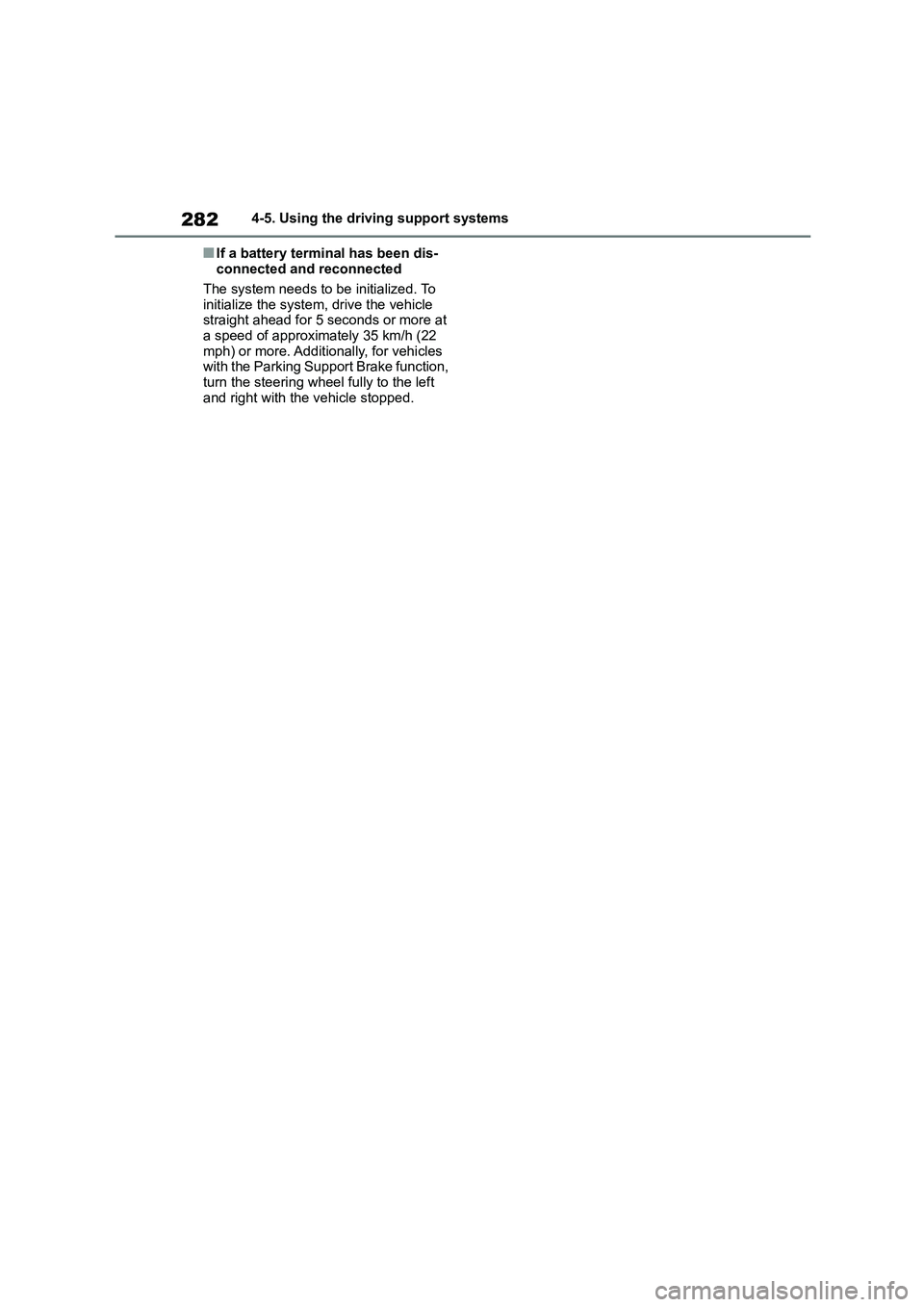
2824-5. Using the driving support systems
■If a battery terminal has been dis-
connected and reconnected
The system needs to be initialized. To
initialize the system, drive the vehicle
straight ahead for 5 seconds or more at a speed of approximately 35 km/h (22
mph) or more. Additionally, for vehicles
with the Parking Support Brake function, turn the steering wheel fully to the left
and right with the vehicle stopped.
Page 308 of 678

3064-5. Using the driving support systems
“Currently Unavailable”
There may be a system failure.
Power steering equipment is temporarily over-
heating.
Turn the engine switch off, wait for a little
while, and then start the engine again.
The engine is not operating.
Start the engine.
Ice, snow, dirt, etc., has adhered to a sensor.
Remove any ice, snow, dirt, etc.
Remove any ice, snow, dirt, etc.
The sensor is frozen.
Once the sensor thaws, the system will
return to normal.
The battery has been removed and reinstalled.
Drive the vehicle straight ahead for 5 sec-
onds or more at a speed of approximately
35 km/h (22 mph) or higher.
“Excessive Speed”
The S-IPA switch is operated when the vehicle
speed exceeds 30 km/h (16 mph).
Operate the switch when the vehicle
speed is approximately 30 km/h (16 mph)
or less.
“Unavailable”
“Try Another Location”
The S-IPA switch is operated in an area with no
parking spaces, or operated in an area where
the road width for parking is narrow.
Assist control cannot be used, as there is
no parking space. Proceed to a parking
space which width is approximately 2.6 m
(8.5 ft.) or larger.
Assist control cannot be used, as the
road width is narrow. Proceed to a park-
ing space where the road width is approx-
imately 4.5 m (15 ft.) or larger.
MessageSituation/Handling method
Page 328 of 678
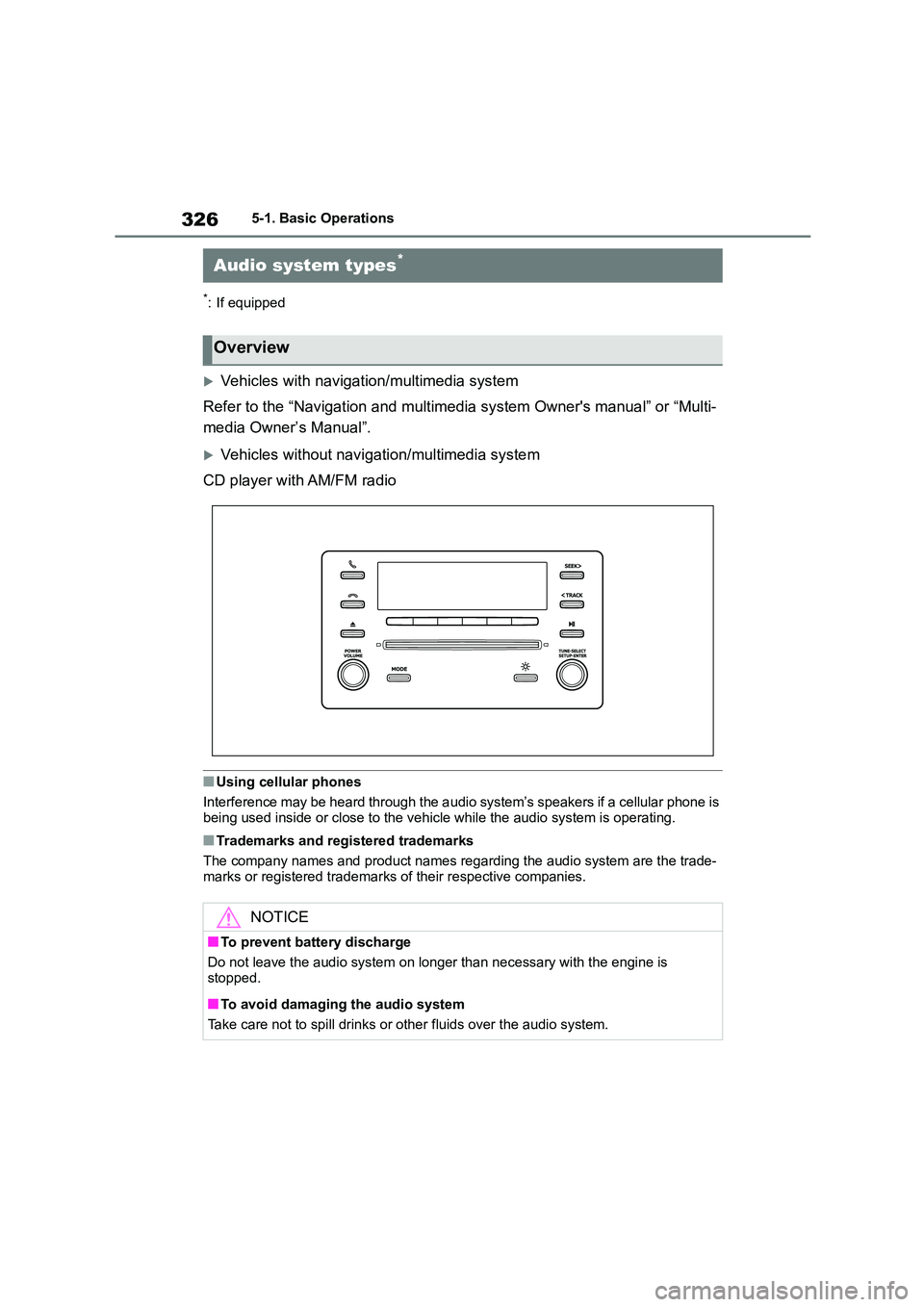
3265-1. Basic Operations
5-1.Basic Operations
*: If equipped
Vehicles with navigation/multimedia system
Refer to the “Navigation and multim edia system Owner's manual” or “Multi-
media Owner’s Manual”.
Vehicles without navigation/multimedia system
CD player with AM/FM radio
■Using cellular phones
Interference may be heard through the a udio system’s speakers if a cellular phone is
being used inside or close to the vehi cle while the audio system is operating.
■Trademarks and registered trademarks
The company names and product names regarding the audio system are the trade-
marks or registered trademarks of their respective companies.
Audio system types*
Overview
NOTICE
■To prevent battery discharge
Do not leave the audio system on longer than necessary with the engine is stopped.
■To avoid damaging the audio system
Take care not to spill drinks or other fluids over the audio system.
Page 385 of 678

383
6
6-1. Using the air conditioning system and defogger
Interior features
Prevent ice from building up on the
windshield and wiper blades.
When the windshield wiper de-icer
switch is on, the indicator illuminates on
the windshield wiper de-icer switch.
The windshield wiper de-icer will auto-
matically turn off after a period of time.
■Location of air outlets
The air outlets and air volume
changes according to the selected
air flow mode.
: If equipped
■Adjusting the position of and
opening and closing the air
outlets
Front center
1 Direct air flow to the left or right,
up or down
2 Turn the knob to open or close
the vent
Front right side
1 Direct air flow to the left or right,
up or down
NOTICE
■To prevent battery discharge
Do not leave the air conditioning sys-
tem on longer than necessary when the engine is off.
Windshield wiper de-icer (if
equipped)
WA R N I N G
■To prevent burns
Do not touch the glass at lower part of
the windshield or to the side of the
front pillars when the windshield wiper de-icer is on.
Air outlet layout and opera-
tions
Page 391 of 678
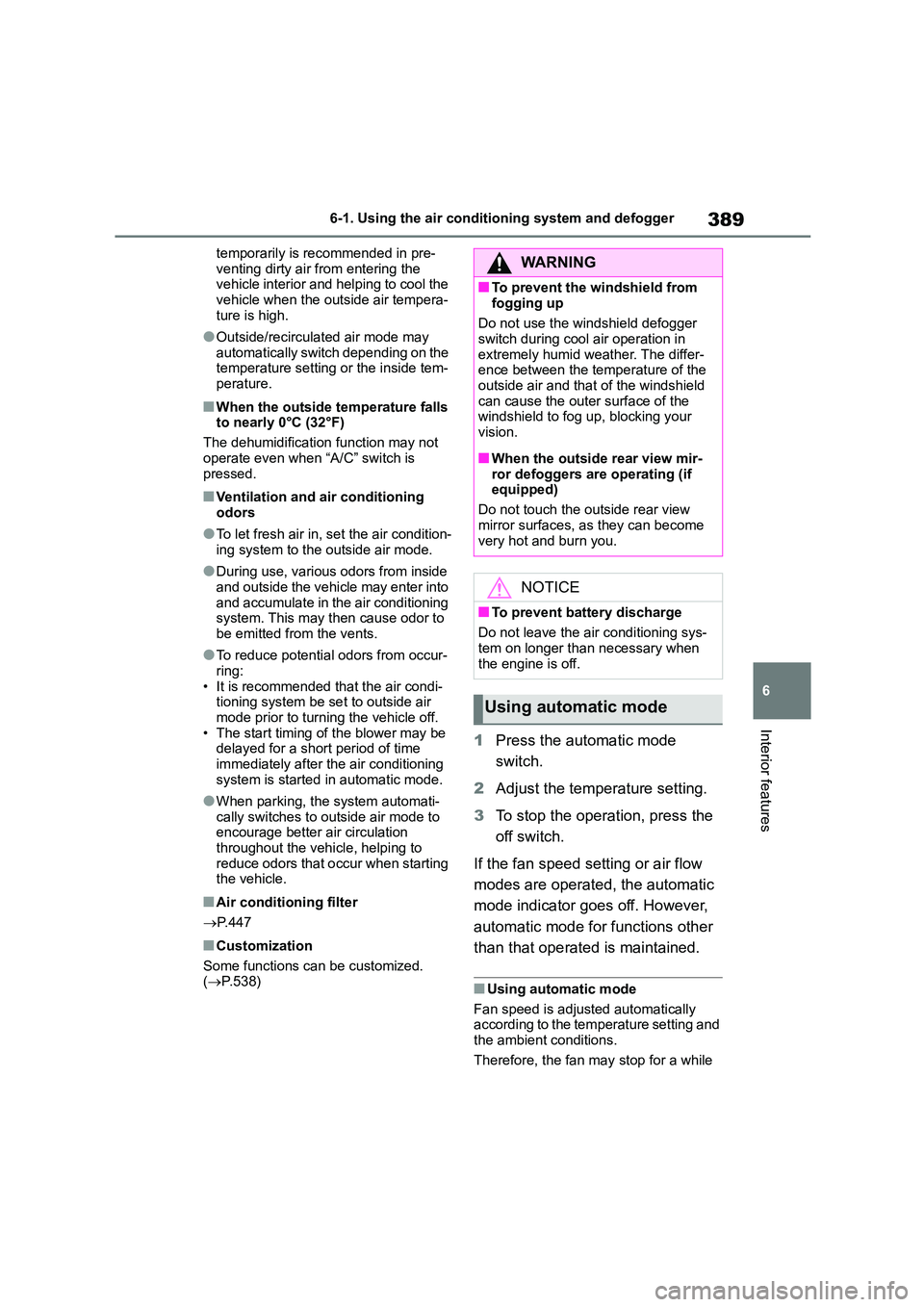
389
6
6-1. Using the air conditioning system and defogger
Interior features
temporarily is recommended in pre-
venting dirty air from entering the vehicle interior and helping to cool the
vehicle when the outside air tempera-
ture is high.
●Outside/recirculated air mode may
automatically switch depending on the temperature setting or the inside tem-
perature.
■When the outside temperature falls
to nearly 0°C (32°F)
The dehumidification function may not
operate even when “A/C” switch is
pressed.
■Ventilation and air conditioning odors
●To let fresh air in, set the air condition-ing system to the outside air mode.
●During use, various odors from inside and outside the vehicle may enter into
and accumulate in the air conditioning
system. This may then cause odor to be emitted from the vents.
●To reduce potential odors from occur-ring:
• It is recommended that the air condi-
tioning system be se t to outside air mode prior to turning the vehicle off.
• The start timing of the blower may be
delayed for a short period of time immediately after the air conditioning
system is started in automatic mode.
●When parking, the system automati-
cally switches to outside air mode to
encourage better air circulation throughout the vehicle, helping to
reduce odors that o ccur when starting
the vehicle.
■Air conditioning filter
P.447
■Customization
Some functions can be customized.
( P.538)
1Press the automatic mode
switch.
2 Adjust the temperature setting.
3 To stop the operation, press the
off switch.
If the fan speed setting or air flow
modes are operated, the automatic
mode indicator goes off. However,
automatic mode fo r functions other
than that operated is maintained.
■Using automatic mode
Fan speed is adjusted automatically
according to the temperature setting and
the ambient conditions.
Therefore, the fan may stop for a while
WA R N I N G
■To prevent the windshield from
fogging up
Do not use the windshield defogger switch during cool air operation in
extremely humid weather. The differ-
ence between the temperature of the outside air and that of the windshield
can cause the outer surface of the
windshield to fog up, blocking your
vision.
■When the outside rear view mir-
ror defoggers are operating (if equipped)
Do not touch the outside rear view
mirror surfaces, as they can become very hot and burn you.
NOTICE
■To prevent battery discharge
Do not leave the air conditioning sys-
tem on longer than necessary when
the engine is off.
Using automatic mode
Page 394 of 678

3926-1. Using the air conditioning system and defogger
*: If equipped
■Heated steering wheel
Turns heated steering wheel on/off
When the heated steering wheel is on,
the indicator illuminates on the heated
steering wheel switch.
■Seat heaters
Front
Turns seat heaters on/off
1 High temperature
2 Low temperature
When the seat heater is on, the indica-
tor illuminates on t he seat heater
switch.
When not in use, put the switch in the
neutral position. The indicator will turn
off.
Rear
Turns seat heaters on/off
When the seat heater is on, the indica-
tor illuminates on t he seat heater
switch.
Heated steering
wheel*/seat heaters*
Heated steering wheel
Warms up the grip of the steering
wheel
Seat heaters
Warm up the seat upholstery
WA R N I N G
■To prevent minor burn injuries
Care should be taken if anyone in the
following categories comes in contact
with the steering wheel or seats when the heater is on:
●Babies, small children, the elderly, the sick and the physically chal-
lenged
●Persons with sensitive skin
●Persons who are fatigued
●Persons who have taken alcohol or
drugs that induce sleep (sleeping drugs, cold remedies, etc.)
NOTICE
■To prevent damage to the seat
heaters
Do not put heavy objects that have an
uneven surface on the seat and do
not stick sharp objects (needles, nails, etc.) into the seat.
■To prevent battery discharge
Do not use the functions when the
engine is off.
Operation instructions
Page 397 of 678
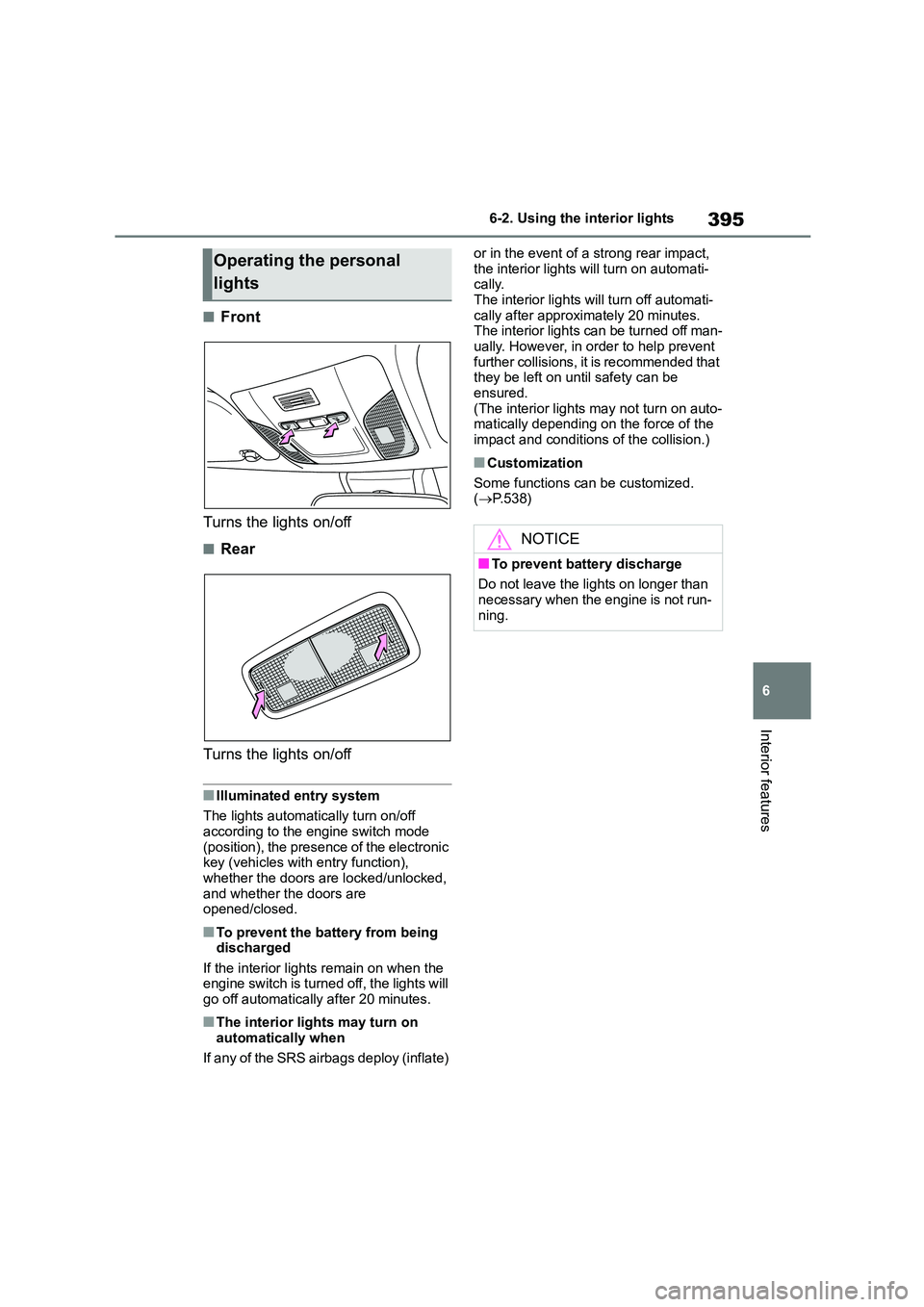
395
6
6-2. Using the interior lights
Interior features
■Front
Turns the lights on/off
■Rear
Turns the lights on/off
■Illuminated entry system
The lights automatically turn on/off according to the engine switch mode
(position), the presence of the electronic
key (vehicles with entry function), whether the doors are locked/unlocked,
and whether the doors are
opened/closed.
■To prevent the battery from being discharged
If the interior lights remain on when the
engine switch is turned off, the lights will go off automatically after 20 minutes.
■The interior lights may turn on
automatically when
If any of the SRS airbags deploy (inflate)
or in the event of a strong rear impact,
the interior lights will turn on automati- cally.
The interior lights will turn off automati-
cally after approximately 20 minutes. The interior lights can be turned off man-
ually. However, in order to help prevent
further collisions, it is recommended that they be left on until safety can be
ensured.
(The interior lights may not turn on auto- matically depending on the force of the
impact and conditions of the collision.)
■Customization
Some functions can be customized. ( P.538)
Operating the personal
lights
NOTICE
■To prevent battery discharge
Do not leave the lights on longer than
necessary when the engine is not run- ning.